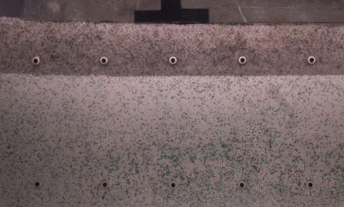|
Overview:
The following how-to videos can be worked through using the example data available for download on the download page. The example data set is of a 200g drum centrifuge test (animated to the right) that was performed at UWA. The test was modelling spudcan foundation punch-through on sand-overlying-clay soil. The first fifty images are provided and are analysed in the following videos, which explore the main features of the GeoPIV-RG subroutines. |
 |
Prerequisites:
The current version of GeoPIV-RG was compiled using MATLAB R2022b on a 64-bit Windows computer. Consequently, to run the main analysis function (which is supplied as an executable file) you must ensure that:
The current version of GeoPIV-RG was compiled using MATLAB R2022b on a 64-bit Windows computer. Consequently, to run the main analysis function (which is supplied as an executable file) you must ensure that:
- A 64-bit Windows computer is used. Mac and Linux machines will not be able to run the main analysis function. We recommend using a Windows computer to run MATLAB as the plot functions are generally more robust.
- The correct MATLAB Runtime version is installed if you are using a version other than MATLAB R2022b. You can download the correct Runtime version by clicking this link. In some instances you may need to install this even if you are using MATLAB 2022b.
- if you haven't installed it already, install Microsoft Visual Studio 2022 C++ Compiler which can be downloaded for free at this link
Setup:
|
|
|
|
|
|
Pre-processing (centroiding, meshing, generating a launch file):
|
|
|
Running an analysis:
|
|
|
Post-processing (filtering, wild subset deletion, image-object space transformation, strain computation):
|
|
|
Basic plotting (displacements and strains):
|
|
|
Bespoke plots (strain paths, measurements overlaid on images) or even animations can be generated using MATLAB by manipulating the output data generated by following the videos above. The subroutines supplied with GeoPIV-RG are intended to provide basic functionality, however, the scope for more sophisticated outputs is essentially endless...